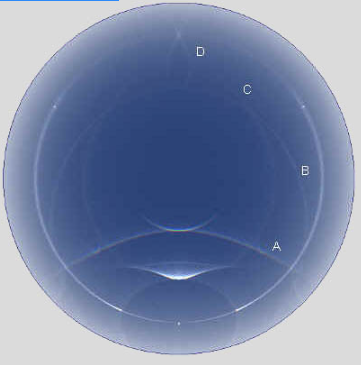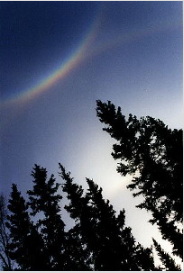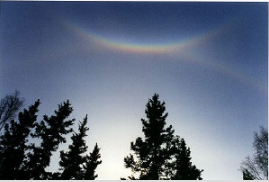Alaska Halos 1999
Alaska Halos 1999: A Spectacular Display of Atmospheric Optics
In 1999, the skies over Alaska treated observers to a breathtaking display of atmospheric optics that lasted over two and a half hours. This remarkable event, described by Walter Tape as one of the best displays witnessed in the Northern Hemisphere, showcased a variety of halos and arcs that captivated both scientists and photographers alike.
The display was brought about by cirrostratus clouds, which provided the ideal conditions for the formation of these optical phenomena. The crystals present in the atmosphere were of exceptional quality and well-oriented, contributing to the clarity and brilliance of the halos observed.
One of the notable features of the Alaska Halos 1999 display was the presence of a range of different halos and arcs. Let's explore some of the remarkable atmospheric optics phenomena that were captured during this extraordinary event:
1. The 22° Halo and Beyond
- The display began with a weak 22° halo, a common optical phenomenon caused by the refraction and reflection of sunlight by ice crystals in the atmosphere.
- Moving upwards from the 22° halo, observers were treated to a fine upper tangent arc, a suncave Parry arc, a supralateral arc (or possibly a 46° circular halo), and a circumzenithal arc.
- Each of these features added to the grandeur and complexity of the display, creating a visual spectacle that left observers in awe.
2. Halos Generated by Crystal Orientation
- The HaloSim simulation, which replicates atmospheric conditions, demonstrated that the halos observed during the Alaska display were likely generated by randomly oriented columns, plate crystals, singly oriented columns, and Parry oriented columns.
- The brightly colored arc, known as arc A in the simulation, was likely a supralateral arc rather than a fragment of a 46° halo. This conclusion was drawn based on the strength of other arcs generated by singly oriented columns, which were prominent in the display.
- The presence of a subhelic arc (B), Wegener arc (C), and Tricker oval (D) added further intrigue to the event. These halos, generated by singly oriented column crystals, are exceptionally rare and their appearance added to the uniqueness of the Alaska Halos 1999 display.
3. Unseen Halos and Arcs
- While the display showcased a remarkable array of halos and arcs, there were certain features that were not visible. Infralateral arcs, which join the supralateral arcs at the parhelic circle, were not well developed during this event.
- The absence of these infralateral arcs did not diminish the overall splendor of the display, as the other halos and arcs provided more than enough visual wonderment.
The photographs captured by Jan Curtis during the Alaska Halos 1999 display beautifully illustrate the magnificence of the atmospheric optics phenomena observed. These images showcase the intricate details and vibrant colors of the circumzenithal and supralateral arcs, leaving viewers in awe of the natural beauty present in our skies.
In conclusion, the Alaska Halos 1999 display stands as a testament to the captivating nature of atmospheric optics. This extraordinary event showcased a range of halos and arcs, each contributing to the mesmerizing beauty of the display. The exceptional quality and orientation of the ice crystals, coupled with the presence of cirrostratus clouds, created the perfect conditions for this breathtaking spectacle. The images captured during this event serve as a reminder of the wonders that can be found in our atmosphere, waiting to be discovered and appreciated by those fortunate enough to witness them.

Aurora photographer Jan Curtis used a 35 mm lens to obtain the image at left. It captures the immensity of the halos better than wide angle and fisheye lenses.
Moving upwards from the weak 22° halo, there is a fine upper tangent arc, a suncave Parry arc, a supralateral arc (or possibly a 46° circular halo) and a circumzenithal arc.
The HaloSim simulation uses randomly oriented columns, plate crystals, singly oriented and Parry oriented columns.
The great Alaska display of 1999 lasted over two and a half hours and was described by Walter Tape as perhaps the best display he had witnessed in the Northern Hemisphere. Cirrostratus clouds produced the display and the crystals were of fine quality and well oriented. Crystal tilts in the simulations had a standard deviation of only half a degree.

The brightly coloured arc A in the HaloSim simulation at right was likely a supralateral arc rather than a 46° halo fragment because, in the display, other arcs from singly oriented columns were strong whereas the 22° halo from poorly oriented crystals was weak.
A subhelic arc, B, Wegener arc, C, and a Tricker oval, D, were visible. These are all very rare halos generated by singly oriented column crystals.
Infralateral arcs (joining the supralateral arcs at the parhelic circle) were not visible: the display was not well developed in that region.
Finally, two more images from Jan Curtis showing the spectacular circumzenithal and supralateral arcs.


Note: this article has been automatically converted from the old site and may not appear as intended. You can find the original article here.
Reference Atmospheric Optics
If you use any of the definitions, information, or data presented on Atmospheric Optics, please copy the link or reference below to properly credit us as the reference source. Thank you!
-
<a href="https://atoptics.co.uk/blog/alaska-halos-1999/">Alaska Halos 1999</a>
-
"Alaska Halos 1999". Atmospheric Optics. Accessed on November 26, 2024. https://atoptics.co.uk/blog/alaska-halos-1999/.
-
"Alaska Halos 1999". Atmospheric Optics, https://atoptics.co.uk/blog/alaska-halos-1999/. Accessed 26 November, 2024
-
Alaska Halos 1999. Atmospheric Optics. Retrieved from https://atoptics.co.uk/blog/alaska-halos-1999/.